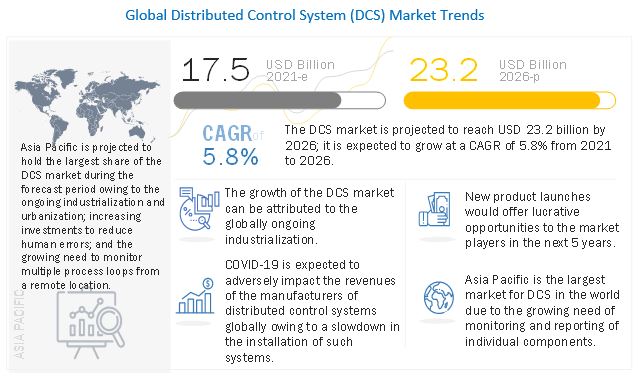Latest report, “Distributed Control System Market by Shipment Scale (large, medium, small), by Component (hardware, software, services), Application (continuous process, batch-oriented process), End-use Industry, and Region – Global Forecast to 2026”
The distributed control system market size will grow to USD 23.2 billion by 2026 (forecast year) from USD 17.5 billion in 2021 (estimated year), at a CAGR of 5.8% during the forecast period.
Distributed control system (DCS) is A distributed control system (DCS) is employed for the handling of processes and plants to provide better control, safety, and product efficiency and quality at plants. Distributed control systems find applications in industries such as oil & gas, power generation, paper & pulp, food & beverages, pharmaceuticals, and chemicals to mainly control manufacturing through two processes: batch-oriented and continuous. The batch-oriented process is used when the production is carried out in subsequent batches, while the continuous process is used for the production type where the production flow does not involve any interruption. Distributed control systems localize the control functions near the process plant. which helps reduce the requirement of monitor/screen, as the process variables can be monitored remotely and decision can be taken accordingly.
Key Market Players:
The leading players in the distributed control system (DCS) market include ABB (Switzerland), Schneider Electric (France), Emerson (US), Siemens (Germany), and Honeywell (US).
Download PDF Brochure – https://www.marketsandmarkets.com/pdfdownloadNew.asp?id=239430160

The software segment is expected to dominate the distributed control system market, by Component, during the forecast period.
The software segment accounted for the largest share of 45.1% of the distributed control system market in 2020. The software segment includes IT applications such as advanced process control systems, controller integration with DCS, technology libraries, telecontrol software, connectivity solutions, parameter control and materials management systems, process optimization and process safety solutions, and advanced software and virtualization solutions. It offers a common platform for devices to connect and operate. Upgrades to existing software, increased use of distributed control systems in cloud computing technologies, and upcoming technologies such as IoT are the major drivers of the software segment of the DCS market. The software solutions are cost-effective and can be replaced and upgraded easily.
The continuous process segment is expected to dominate the DCS market, by application, during the forecast period.
The continuous process segment accounted for the largest share of 66.4% in 2020. The continuous process segment, by application, is projected to hold the highest market share during the forecast period. The continuous process is a method where the manufacturing process is carried out without any interruption and is generally preferred when producing large quantities. It is the faster-growing application in the distributed control system market. The continuous production process is used in oil & gas, chemicals, power generation, and water & wastewater treatment industries and is one of the more efficient and profitable methods of production. The use of distributed control systems in nuclear as well as renewable sectors in the power generation industry and in upstream and downstream activities in the oil & gas industry are the major factors driving the continuous process segment. The increasing production of chemicals and the growing demand for distribution control systems in the refining industry also contribute to the segment’s growth.
Speak to Analyst – https://www.marketsandmarkets.com/speaktoanalystNew.asp?id=239430160
The oil & gas segment is expected to dominate the distributed control system market, by end-use industry, during the forecast period.
The oil & gas segment accounted for the largest market share of 25.9% in 2020. Oil & gas is one of the largest industries in terms of revenue generation for the DCS market and is classified into 3 major sectors-upstream, midstream, and downstream. The upstream sector involves the extraction, development, and production of crude oil and natural gas, the midstream sector includes the transportation and storage of crude oil and refined petroleum products, and the downstream sector consists of companies involved in refining crude oil, producing petroleum products, and selling these products through wholesale and retail channels. The processes carried out in this industry are highly complex, lengthy, and critical. Distributed control systems are widely applied across all sectors of the oil & gas industry, as these systems ensure safety, reliability, and profitability in oil & gas operations.
Asia Pacific is expected to lead the DCS market
Asia Pacific accounted for a 32.3% share of the distributed control system market in 2020. The countries covered in the region are China, Japan, South Korea, India, and the Rest of Asia Pacific. The market is expected to grow due to booming power sector and augmented power generation capacities worldwide, growing industrial infrastructure, and increased use of renewable and nuclear energy for power generation.
The DCS market is expected to grow in countries such as China and India due to infrastructural expansions, ongoing power generation projects, and technological innovations. The distributed control system market in this region is expected to grow due to rapid regional industrialization, urbanization, and economic growth, which are leading to the installation of new distributed
China is one of the largest markets for distributed control systems and the fastest-growing economy in the world. The government is continuously supporting clean energy projects and focusing on reducing carbon emissions, which would lead to strong growth rate of the power industry in the future. The rapid economic growth would increase the demand for power. Which would need greater investments in power plant infrastructure to fulfill the demand. Hence, investments in such areas would boost the demand for distributed control systems. Automation is increasing in APAC because of the rising need for high-quality products and increasing production rates. It also helps reduce labor costs and human interference.
The region is the largest energy consumer globally, with China and India leading the growth in power generation and consumption. distributed control system market has tremendous potential in Asia Pacific, mainly due to the rapid economic growth in China.
Request Sample Pages – https://www.marketsandmarkets.com/requestsampleNew.asp?id=239430160


